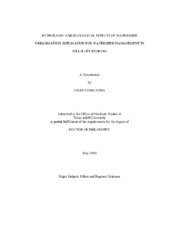| dc.contributor.advisor | Li, Ming-Han | |
| dc.creator | Sung, Chan Yong | |
| dc.date.accessioned | 2011-08-08T22:48:09Z | |
| dc.date.accessioned | 2011-08-09T01:28:51Z | |
| dc.date.available | 2011-08-08T22:48:09Z | |
| dc.date.available | 2011-08-09T01:28:51Z | |
| dc.date.created | 2010-05 | |
| dc.date.issued | 2011-08-08 | |
| dc.date.submitted | May 2010 | |
| dc.identifier.uri | https://hdl.handle.net/1969.1/ETD-TAMU-2010-05-7962 | |
| dc.description.abstract | In this study, I examined the effect of watershed urbanization on the invasion of alien
woody species in riparian forests. This study was conducted in three major steps: 1)
estimating the degree of watershed urbanization using impervious surface maps
extracted from remote sensing images; 2) examining the effect of urbanization on
hydrologic regime; and 3) investigating a relationship between watershed urbanization
and ecosystem invasibility of a riparian forest.
I studied twelve riparian forests along urban-rural gradients in Austin, Texas.
Hydrologic regimes were quantified by transfer function (TF) models using four-year
daily rainfall-streamflow data in two study periods (10/1988-09/1992 and 10/2004-09/2008) between which Austin had experienced rapid urbanization. For each study
period, an impervious surface map was generated from Landsat TM image by a support
vector machine (SVM) with pairwise coupling. SVM more accurately estimated impervious surface than other subpixel mapping methods. Ecosystem invasibilities were
assessed by relative alien cover (RAC) of riparian woody species communities.
The results showed that the effects of urbanization differ by hydrogeologic
conditions. Of the study watersheds, seven located in a hillslope region experienced the
diminishing peakflows between the two study periods, which are contrary to current
urban hydrologic model. I attributed the decreased peakflows to land grading that
transformed a hillslope into a stair-stepped landscape. In the rest of the watersheds,
peakflow diminished between the two study periods perhaps due to the decrease in
stormwater infiltration and groundwater pumpage that lowered groundwater level. In
both types of watersheds, streamflow rising during a storm event more quickly receded
as watershed became more urbanized.
This study found a positive relationship between RAC and watershed impervious
surface percentage. RAC was also significantly related to flow recession and canopy gap
percentages, both of which are indicators of hydrologic disturbance. These results
suggest that urbanization facilitated the invasion of alien species in riparian forests by
intensifying hydrologic disturbance.
The effects of urbanization on ecosystems are complex and vary by local
hydrologeologic conditions. These results imply that protection of urban ecosystems
should be based on a comprehensive and large-scale management plan. | en |
| dc.format.mimetype | application/pdf | |
| dc.language.iso | en_US | |
| dc.subject | remote sensing | en |
| dc.subject | subpixel mapping | en |
| dc.subject | hillslope hydrology | en |
| dc.subject | transfer function model | en |
| dc.subject | hydrologic drought | en |
| dc.subject | urban ecology | en |
| dc.subject | biological invasion | en |
| dc.title | Hydrologic and Ecological Effects of Watershed Urbanization: Implication for Watershed Management in Hillslope Regions | en |
| dc.type | Thesis | en |
| thesis.degree.department | Landscape Architecture and Urban Planning | en |
| thesis.degree.discipline | Urban and Regional Sciences | en |
| thesis.degree.grantor | Texas A&M University | en |
| thesis.degree.name | Doctor of Philosophy | en |
| thesis.degree.level | Doctoral | en |
| dc.contributor.committeeMember | Rogers, George O. | |
| dc.contributor.committeeMember | Volder, Astrid | |
| dc.contributor.committeeMember | Wang, Zhifang | |
| dc.type.genre | thesis | en |
| dc.type.material | text | en |


